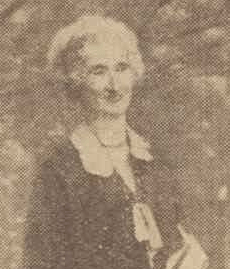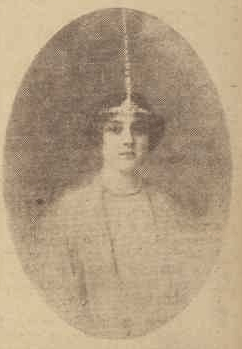Ada Whiting facts for kids
Ada Whiting was a talented Australian artist. She was known for painting tiny, detailed portraits called miniatures. She also painted with oil and watercolour. From 1898 to 1944, she painted many important people. These included famous leaders and well-known people in society. She worked in Melbourne and Sydney.
Contents
Ada Whiting's Early Life
Ada Clara Cherry was born in Hobart, Tasmania, in 1859. Her father, George Cherry, was also an artist and photographer. Ada was one of five children. After her parents passed away when she was young, Ada moved to Geelong with her brothers and sisters.
She went to the Geelong Technological School and School of Drawing. Ada was very good at art. In 1874, she won first prize for drawing people. In 1879, she won awards for drawing flowers and shells. Her art was also shown in exhibitions in Melbourne.
Ada later worked at a photography studio called Johnstone, O'Shannessy and Co. She would add colours by hand to photographs. In 1888, she married Saville Whiting, who was also a photographer. Ada and Saville later separated. By 1893, Ada had her own art studio. She worked hard to support herself and her children.
Becoming a Famous Artist
Ada's father knew a famous artist named Arthur Streeton. Maybe he suggested she try painting miniatures. Ada learned special skills for this art. One technique was "stippling," which means using tiny dots with a very fine brush.
Ada became well-known when one of her early miniatures was shown in London. This was at the Royal Academy in 1900. Painting miniatures took a lot of time. But Ada was known for working quickly. Her watercolour miniatures on ivory were greatly admired.
She usually needed only a few sittings with her subjects. She was also good at painting from photographs. This was helpful for painting people who had passed away. This type of request was quite common.
In 1900, her miniatures were shown in Fitzroy. People thought they were "daintily pretty." By 1901, Ada had her own studio in Collins Street, Melbourne. Her success in London brought her many important clients. Her skill in creating miniatures was widely recognized.
In 1902, newspapers noted she was painting many children from important families. In 1904, the National Art Gallery in Sydney showed her miniatures. In 1905, they bought three of her works for their collection. One of these was a portrait of Miss Ruby Webb.
In 1909, Ada was asked to show her art at the Federal Art Exhibition. Her four miniature pictures were praised. People said they were "all that can be desired in this delicate branch of art."
From 1915, Ada continued to show her work. She received many important jobs. Newspapers often praised her, saying she was "at the head of her profession." These good reviews helped her keep her reputation. She often visited her son in Sydney. There, she painted members of the wealthy Hordern family. She also painted the daughter of the NSW Governor.
Ada painted many famous people. These included the art supporter Alfred Felton. She also painted the Earl of Linlithgow.
Ada Whiting and Dame Nellie Melba
Ada Whiting painted many miniatures of Dame Nellie Melba. Melba was a world-famous singer and a close friend of Ada. In 1903, Ada completed two more miniatures of Melba. A newspaper writer called Ada "the most accomplished" miniature artist in Melbourne. One of these miniatures was for Melba's friend, Miss Violet Clarke.
In 1904, Melba sent a message from Paris. She asked Ada to paint her father, David Mitchell. Even though he didn't want to sit for a portrait at first, it was quickly finished. Melba received it in London. She called the miniature her "dearest treasure." Melba also asked Ada to paint a miniature of author Beverley Nichols. Melba took this portrait to London for his mother.
In 1919, Ada painted Melba wearing a special tiara. She was also wearing "a lace gown with camellias." Melba had worn this outfit when she performed in the opera La Traviata.
Ada never traveled outside Australia. Melba encouraged her to go abroad. She even offered to introduce Ada to important people. But Ada stayed in Australia. A writer for a Melbourne newspaper wished Ada had "a wider field of action."
Melba continued to support Ada's work. In 1919, before leaving for London, Melba spoke about her friendship with Ada. She said, "I have had some miniatures painted by Mrs Whiting and they are very beautiful. She talks of coming to London. I hope she will." Ada also painted a miniature of Melba's granddaughter, Pamela. Melba carried this "dainty bijou" in her suitcase like a lucky charm.
Later Years
Over time, people became less interested in miniatures. But Ada Whiting still received commissions. She continued to show her art regularly. She was mentioned in annual exhibitions of the Victorian Society of Artists. This happened in 1925, 1926, 1930, and 1933.
In 1934, Ada was invited to send her work to the Paris Salon. She sent her portrait of "Australia's loveliest girl," Jessica Harcourt. Ada mostly stopped painting miniatures when her eyesight began to trouble her. She used a magnifying glass for some jobs. She completed her last miniature in 1944.
Almost until her death in 1953, Ada was painting larger works. These were mostly flowers painted with oils. She passed away at her son's home in North Brighton, Melbourne.
Exhibitions
- 1896-1916: Victorian Society of Artists
- 1900: Royal Academy London
- 1905: Royal Art Society, Melbourne
- 1909: Federal Art Exhibition, South Australian Society of the Arts
- 1917: Royal Scottish Academy
- 1934: Royal Hibernian Academy
- 1934: Paris Salon
External sources
Works are in the collections of:
- Miss Ruby Webb, 1905. Art Gallery of NSW
- Miss Jessica Harcourt, 1925. Finalist, Archibald Prize, 1925
- National Gallery of Victoria
- Australiana Magazine, November 2009
- Portrait of Ada Cherry, 1863 by her father George Cherry



